Seven key charts for investors to keep an eye on
Despite lots of uncertainty in the last six months – notably about the impact of Trump’s tariffs but also around war with Iran - share markets have been fairly resilient. However, uncertainty remains high. This note updates seven key charts worth watching.
Chart 1 – the US tariff rollercoaster
US tariffs have been the big driver of swings in global share markets this year and may remain so for a while yet.
We started the year with an average US tariff of around 3%. It then shot up post “Liberation Day” in early April to over 30% as Trump announced “reciprocal tariffs” on all countries ranging from 10% to 49%, with a bout of tit-for-tat between the US and China pushing the tariffs on China to 145% at the same time as tariffs of 25% on autos and 50% on steel and aluminium.
We then saw 90 day pauses at the 10% baseline tariff to allow time for negotiation which with 40% on China and the sectoral tariffs saw the average fall back to around 14%. While deals have been cut with the UK which locked in 10% and Vietnam which saw a 20% tariff, Trump has now announced tariffs for numerous countries (ranging from 25% for Japan and South Korea to 40% for Myanmar) which are around the levels announced in early April to commence on 1st August, unless they cut trade deals before.
While the further pause to 1st August is welcome, it looks like we are on the way back up again with the tariffs, maybe to around 20% or so once more sector tariffs are allowed for (eg Trump is talking about 50% on copper and 200% on pharmaceuticals), which maintains the threat to the US and global growth outlooks.
This in turn risks another correction in share markets into the seasonally weak months of August and September, but it may not be as severe this time as investors understand the risks a bit better.
Where it ultimately settles is hard to know. On the one hand, Trump is being emboldened by the resilience of US growth, still low inflation and record highs for shares. So, it’s not a bad time for him to throw another tariff tantrum.
But we also know from the experience in April that if investors riot too much he will back down to avoid a bear market, bond yield blowout and recession.
So, while a renewed near-term rise in US tariffs is a bad thing, it’s likely to prove temporary again with Trump back peddling once more. Note that uncertainty also remains around the legal status of the reciprocal tariffs although Trump can likely base these tariffs on other laws.
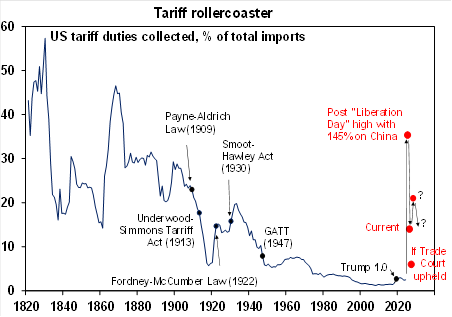
Australia looks likely to see the 10% baseline tariff remain – which was its “Liberation Day” rate – and we will likely soon see pharmaceuticals hit as well. But with Australian exports to the US being less than 5% of total goods exports the overall impact is likely to be minor.
The key for Australia is the extent of any damage to the global economy from tariffs and hence the flow on to Australia from weaker global growth.
Chart 2 – global business conditions PMIs
As always, a key driver of how shares perform over the next 6-12 months will be whether major economies including Australia avoid recession. This has been much feared but avoided in recent times, but providing recession is avoided any fall in shares will be relatively short term in nature.
A key in all of this will be how much damage the tariffs cause to global growth and business conditions PMIs will provide a key early warning of this. So far, they are slowing but not collapsing.
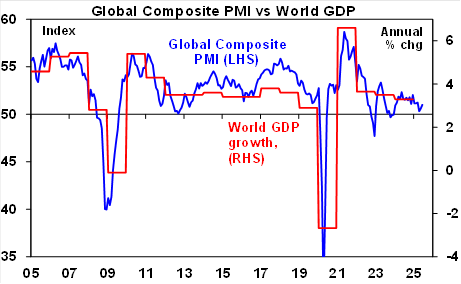
Chart 3 – longer term inflation expectations
The good news from the 2021-22 inflation surge was that medium term inflation expectations remained at low levels which made it easier for central banks to get inflation back down. But this year the US tariff announcements have seen some measures of US consumers’ inflation expectations move up. See next chart.
This along with uncertainty about the direct impact of the tariffs on inflation is keeping the Fed on hold at a time when they would otherwise be cutting rates.
We expect that they will likely start to cut in a few months which will be positive for shares, but high inflation expectations could derail this. This is not an issue for other countries including Australia as it’s the US imposing the tariffs.
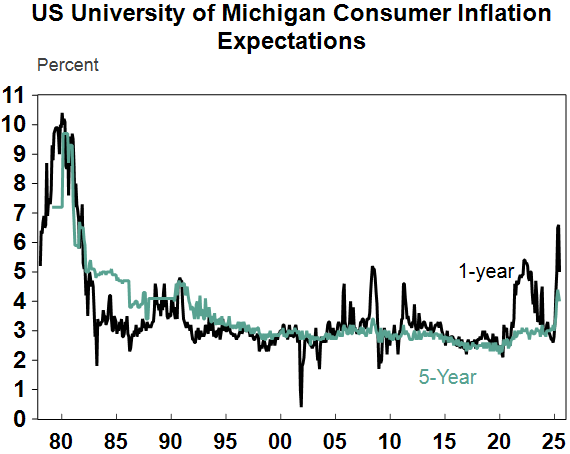
Chart 4 – inflation (and hence interest rates)
Just as important is that inflation continues to trend sustainably back to central bank targets (which is 2-3% in Australia and around 2% in other comparable countries). Apart from a likely one-off boost in the US from Trump’s tariffs, we think it will enable central banks to cut rates further.
In Australia, underlying inflation is already around target and while the RBA paused rate cuts in July, we see four more 0.25% cuts with the next in August taking the cash rate down to 2.85% next year albeit it may take a bit longer than we expected just prior to the latest RBA meeting.
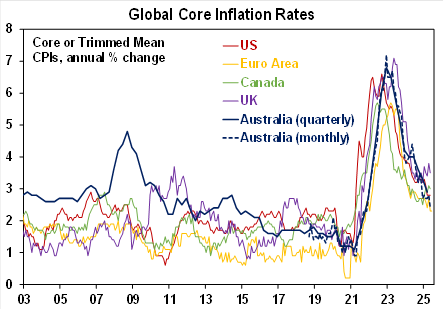
Chart 5 – company profits
Consensus 12 month ahead earnings expectations for the US are around 10% and for Australia are around 1%. In the US they have been getting revised down, but not much more than normal (see blue line in next chart).
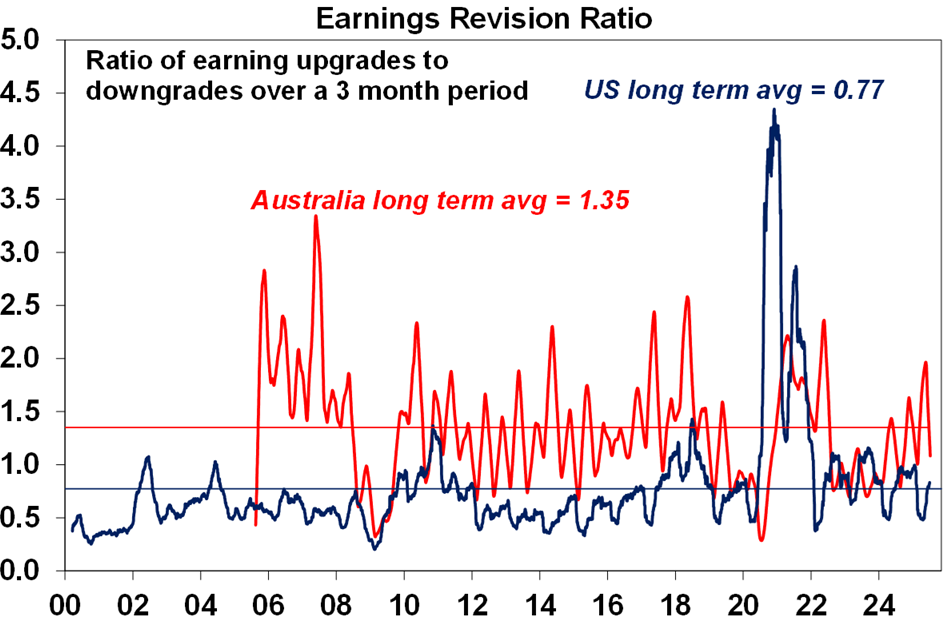
And in Australia, there has been something of an improving trend in revisions after falling earnings since 2022-23 (see the red line in the chart). The main threat to US earnings arises from the impact of the tariffs on demand and margins and a recent cooling in consumer spending. In Australia, the main risk is that consumer spending stays weak.
Upcoming earnings reporting seasons notably in the US starting this month and Australia next month will be key.
Chart 6 – the gap between earnings and bond yields
Valuation is a poor guide to timing share markets but can help tell us how attractive their medium-term return potential is and how vulnerable they may be to a big move down or up. Since 2020, rising bond yields and rising/elevated PE multiples have seen a deterioration in share valuations.
For example, the gap between earnings yields and bond yields - a proxy for shares’ risk premium – has been bouncing around zero in the US and only a bit better in Australia. This leaves both markets vulnerable to bad news. By contrast Eurozone and Chinese shares are cheaper. Ideally lower bond yields and higher earnings are required.
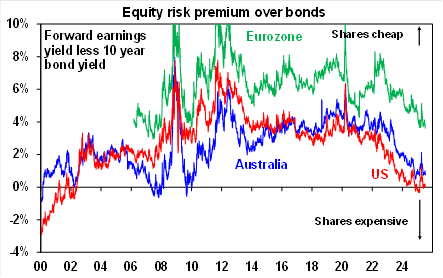
Chart 7 – the US dollar
Normally in times of uncertainty the $US rises (and the $A falls) as the US economy has less exposure to cyclical sectors. So far this year the normal relationships have been upended as Trump’s erratic policymaking has unnerved investors in US assets putting downwards pressure on the $US at a time when it was overvalued.
This has seen the $US have its weakest start to a year since Nixon was President. Right now, the $US is technically oversold so could have a bounce which could see the $A fall.
But if the $US continues its sharp downtrend it could increase the risk of a US public debt crisis which runs the risk of higher bond yields impacting share markets.
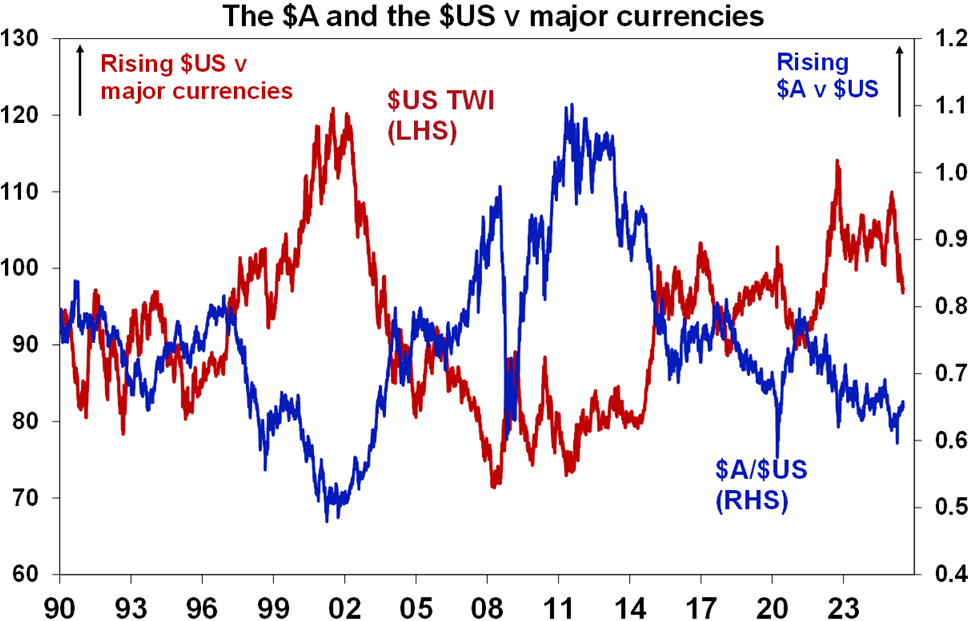

2 topics
